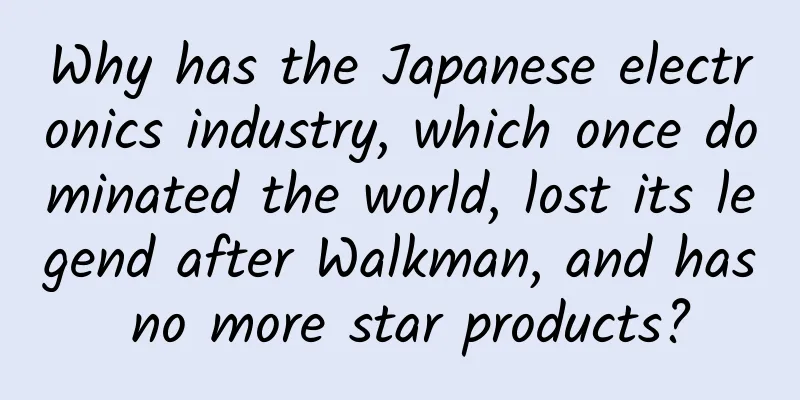Why has the Japanese electronics industry, which once dominated the world, lost its legend after Walkman, and has no more star products?

|
In the 1970s, the Japanese government implemented the "mechatronics" policy that closely combined mechanical technology and microelectronics technology. The industry created a modern manufacturing model and management method of lean manufacturing, and the Japanese electronics industry was all the rage. In recent years, Japanese electronic brands such as Sony and Sharp have lost their former glory in the digital age. The once prosperous Sharp Group suffered huge losses in the field of LCD screens, and its stock price plummeted by several percent, and it was on the verge of bankruptcy. The financial report for the 2016 fiscal year showed that Sony's net profit was 73.3 billion yen, a year-on-year decrease of 50.4%. In the 2011 fiscal year, Sony's net loss was 456.7 billion yen, equivalent to about 5.9 billion US dollars, setting a historical record. In 2016, Toshiba's crisis continued, its stock price was almost halved, and its market value evaporated by about 800 billion yen. Epson, which has always performed well, only made a profit of 5 billion yen, a decrease of 51%. The ranking of deficit companies in the past 10 years by Japan's "Toyo Keizai" magazine showed that Panasonic, Sharp, and Sony ranked 2nd, 3rd, and 11th respectively. Some analysts believe that the Japanese electronics giants were defeated by the digital revolution. The slow transformation and slow and stubborn decision-making made the Japanese electronics giants unable to keep up with the changes in the market and technological innovation, leading to their collective collapse. I believe everyone is familiar with this brand: Sanyo. At that time, Sanyo-branded recorders were all the rage. Not only Sanyo, but also when China just entered the era of reform and opening up, my family had a Japanese appliance, imported from Japan, and you felt that you were superior to others. Why? At that time, Japanese appliances represented the highest level of household appliances and consumer electronics in the world, and the brands of many Japanese electronic companies were also supported by global consumers. How many well-known Japanese electronic companies were there at that time? Let's just count them casually, like Sanyo, Sony, Panasonic, Toshiba, Hitachi, Sharp, NEC, Canon, Olympus, and when they were developing digital cameras, they continued to be popular for a while. There were also so-called printers, various office products, and Fujitsu, NEC, etc. There was also a well-known printer manufacturer at that time called Epson. In short, there were 11 major Japanese electronic companies at that time, forming a Japanese electronic army that swept the global market. But now, many of Japan's industry-leading companies at that time have become silent, and even very miserable. For example, there is a very well-known company called Sony. I believe that everyone is most familiar with Sony's products. The Walkman in the early years can be said to be when Nobuyuki Ito was in charge of Sony. At that time, Sony could be said to be the global electronics industry. Not only was it the leader in sales, but it was also a holy place in the minds of many product engineers and designers. For example, Mr. Steve Jobs, who we later highly respected, was very impressed by Sony's Walkman at the very beginning. When he communicated with the Apple designer team to jointly promote the so-called I series of products, iPod, iPad, iPhone series, and the design of the entire IMAC series, Sony's Walkman was once the object of their repeated disassembly, research, and comparison. At the same time, Sony also had a large number of laptops and digital cameras at the time. Sony and its joint venture Sony Ericsson mobile phones also became very popular products for consumers all over the world in various vertical fields. But today, let's break down Sony's product lines. First, Sony suspended and discontinued its core VAIO computer series products three years ago in 2014. The discontinuation of this product series meant that Sony officially withdrew from the notebook and personal computer fields. At the same time, dear friends, how long have you not seen Sony and Sony Ericsson smartphones? How long have you thought of the Sony brand when buying a mobile phone? These are enough to explain everything. And the Sony headquarters building we saw in New York, USA, has actually been sold at a discount. Looking at the decline of the various Japanese electronics industries and Japanese electronics companies, what are the internal and external causes? First, the entire electronics industry in Japan has always been stuck in a semi-closed or even very closed standard state. The development of the entire global electronics industry is actually driven by two, six words: standardization and networking. If we add a third word, the third word is intelligence. Let's look at the standard first. In the entire Japanese electronics industry system, they have always been very stubborn in sticking to a Japanese local standard, and tried to use their once very high market share to promote their own standards to the world. However, they refused to recognize some open standards that have become universal in the network era, in the Internet era, and in the digital era. Let's take the simplest example of MP3. In fact, we know that MP3 is the most common choice for friends who listen to music, but it is definitely not the best choice, because even if the compression bit rate of MP3 reaches a very high quality, it is still called lossy compression, and the sound quality is lossy. For very few, very few, very few music enthusiasts, MP3 is indeed not pleasant to the ears, and we must listen to lossless APE or other formats. However, Sony made a major decision-making mistake on this point. On the one hand, it was to protect the copyright of music, and on the other hand, it took its pursuit of excellence to a somewhat excessive and exaggerated extreme. MP3 became popular on the Internet 20 to 30 years ago. In the 1990s, the MP3 format began to appear, refusing to be recognized and compatible. So we can see that even though it has such a strong Walkman brand and even though it once followed the footsteps of Apple iPod and launched some digital music player products, it was completely defeated under the attack of iPod. In the end, in the music market in the network and digital field, it handed over the crown of the first market and the crown of the first brand appeal to Apple and iPod. Let's talk about computers. The decline and weakness of the entire Japanese computer industry actually started in the 1980s, because at that time, both the Japanese government and the Japanese electronics industry had determined a basic national policy of semi-isolation and development of their own unique set of things. In contrast, we can see that although China did not have the ability to develop a popular civilian operating system OS at the beginning, we have used the strategy of exchanging market for space and industrial development for time. We have Lenovo, Founder and a series of well-known computer brands. After these computer brands have formed the first position in market share, our Red Flag LINUX based on the LINUX open source standard has actually fired the first shot of our domestically produced independent computer operating system. It can be said that between such national strategy and industrial strategy, we have left Japan far behind. I think the first fatal reason for the decline of Japan's entire electronics industry is that the standard is closed. It is not an open system. In 1990, what did Japanese semiconductor companies occupy in the top ten semiconductor rankings in the world? They occupied six places. Let's see that the purple marks are Japanese companies, NEC, Toshiba, Hitachi, Fuji, etc. They occupy the top six places. Among the top 20 semiconductor companies in the world, Japanese companies occupy 12 places. By 2016, only three of the world's top 20 semiconductor manufacturers were from Japan. This was the second biggest mistake made by the entire industry. What was this mistake? It was a serious misjudgment of the strategic direction. The third major reason is that we must first talk about a positive case. We just said that Japanese companies are not doing well now. Are there any companies that are doing well? Yes, there are. Let's look at the company that is doing well, which is called Fujifilm. This is a comparison of Fujifilm in different fiscal years of 2000 and 2014. In these fourteen or fifteen years, Kodak has fallen, but Fujifilm of Japan has not only nearly doubled its turnover, but also its profit has exceeded that of 2000. Fujifilm's boss, Fujifilm's board of directors, and the board of directors once made a famous resolution, which is to say whether to vigorously develop digital cameras. In the future digital imaging era and the future health era, how we can transform based on our core technology is the most critical, rather than based on our core departments. It is no exaggeration to say that every female comrade now deals with Fuji every day, because all the cosmetics you put on your face contain Fuji's patents. This is a successful transformation. Based on this, we can infer the third reason for the overall decline of the entire Japanese electronics industry in the past decade or so. It is that they did not do what Fuji did, and truly understood the future development of the company based on their core technologies rather than their specific business departments. When Apple first declined in the mid-1980s, it suffered from Jobs' unreasonable stubbornness and unprincipled enthusiasm for closed systems. But when Jobs returned to Apple, although he still took a self-centered attitude in design and system, we can see that the Apple Store is open. It distributes hundreds of billions of dollars to developers around the world every year, provides hundreds of millions of mature applications, and has set a very open model and example for the global mobile Internet ecosystem, right? Its thinking has changed. We must believe in the Internet, believe in everyone for me, and I for everyone, believe in the power of the platform, and believe in the power of openness. The second revelation is that Chinese enterprises must pay attention to the technical reserves for the next, two or even three steps in the future. The third point is also very critical: do not be too happy when you are proud. We have seen such a saying, which is very interesting: when an entrepreneur starts to write an autobiography, the enterprise often starts to go downhill; when a company starts to buy buildings in prime locations, the company is likely to go downhill. We saw that Sony was indeed like this. After creating collective glory, Japanese companies are a bit resting on their laurels and not moving forward, or stagnating. As Bill Gates said, any company is only 360 days or 180 days away from bankruptcy. The Japanese government and business community attach great importance to the development of artificial intelligence. They not only regard the Internet of Things, artificial intelligence and robots as the core of the fourth industrial revolution, but Japanese Prime Minister Shinzo Abe has called on companies to make good use of AI and robots. He encouraged companies to increase their investment in the research and development of new technologies. Fujitsu executives said that they are now more open in showing the latest AI research and development results, providing consulting services to customers and applying technology to enterprises. NEC Senior Vice President Xiang Jiangcun said that if we compete with Google in the same battlefield, we may not win, but in certain specific areas, such as facial recognition, we don’t want to lose. Some Japanese companies are also looking for partners abroad to develop together. For example, SoftBank and IBM have cooperated to introduce the Watson AI system into the humanoid robot Pepper. Ruikeli Group, a human resources company under the automaker Toyota, has sought talents from Google and well-known American universities to establish an AI laboratory in Silicon Valley. As for the entire Japanese electronics companies and industries, they still have a large number of patents that are very valuable, and we have actually noticed that Japanese companies are already looking for different new directions for breakthroughs. In the first direction, for example, we see robots, artificial intelligence and robots. It should be said that its core algorithm is led by Americans, such as AlphaGo and AlphaGo 0, and China is also unwilling to lag behind. For example, we have our iFlytek, we have the Chinese Academy of Sciences' special research on artificial intelligence, and many patent results. But in terms of specific forms and specific products, Japan is indeed at the forefront of the world. The second direction is that Japan was once a world-renowned automobile power, a leading country in automobile production, with many automobile brands. Although it is said that it is impacted by Tesla and many other Chinese automobile companies today, for example, this is Tesla, this is our Daqin, and this is BYD. BYD or Tesla, these are all leaders in the field of electric vehicles, but do you know? Tesla's battery system is actually provided by the Japanese company Panasonic. In such a new energy system, according to the relevant materials I have, many Japanese companies are working hard on new, less polluting, extremely low-pollution controllable nuclear energy and electric energy, as well as more new energy sources, and these may very likely create and lay the foundation for the next stage, because things change over time. Another point is new energy and new materials, such as graphene and combustible ice, which actually determine the post-fossil fuel stage of human society and civilization. Now we are all petrochemical fuels, oil, natural gas, etc. In the era of new energy and new materials after chemical fuels, our core competitiveness, and Japanese companies also have opportunities in this regard. Our Chinese companies and industries can explore, open up, discover and innovate the latest space of the universe together with industries from all over the world, including Japan, the United States, South Korea, etc., and reach the latest plane of the innovative universe. In this way, there will be a real market harmony and world harmony with industrial prosperity. As a winner of Toutiao's Qingyun Plan and Baijiahao's Bai+ Plan, the 2019 Baidu Digital Author of the Year, the Baijiahao's Most Popular Author in the Technology Field, the 2019 Sogou Technology and Culture Author, and the 2021 Baijiahao Quarterly Influential Creator, he has won many awards, including the 2013 Sohu Best Industry Media Person, the 2015 China New Media Entrepreneurship Competition Beijing Third Place, the 2015 Guangmang Experience Award, the 2015 China New Media Entrepreneurship Competition Finals Third Place, and the 2018 Baidu Dynamic Annual Powerful Celebrity. |
Recommend
Google's new self-driving car skill: three-point turn
There is a test item in the US driver's licen...
Porsche's alliance with SAIC may help resolve the crisis
According to the latest information from the Secu...
Apple eats the meat, Android drinks the soup, has the tablet market entered the end game ahead of time?
Not long ago, the well-known market analysis orga...
The "whitening secrets" you've heard of are useless! Check out these 3 tips, they can really whiten your skin, and they're safe!
As the saying goes, a white complexion hides a hu...
Lao Wang from the west of the village: A training camp to teach you how to make lessons (completed) worth 799 yuan
The course is divided into 5 chapters (the underl...
[Smart Farmers] Magnolias are both beautiful and talented: they are more than just for viewing
In China, flowers bloom in May in Beijing, in Apr...
China Association of Automobile Manufacturers: A brief analysis of the sales of the top ten SUV manufacturers from January to March 2023
According to statistics and analysis by the China...
Unveiling the secrets of karst carbon sinks: the never-ending “carbon capture expert”
The global karst distribution area is 22 million ...
Intel is the foundry for Chinese chips. Domestic CPUs are rising and competing with Qualcomm
On February 27, Spreadtrum Communications announc...
How to grow the "Zebra AI Class" app!
The app has been downloaded 28 million times in t...
Analyzing the secrets behind "Xiaohongshu live streaming"
What secrets are hidden behind Xiaohongshu’s live...
[Tutorial] How did a 16-year-old hacker install Windows 95 on a smartwatch?
Corbin Davenport, a 16-year-old hacker from Georg...
A "golden seed" creates a "bountiful" scene for beer and wheat!
"The yield per mu is 767.5 kg! This is a new...
These WeChat bugs are super funny. Sending this sentence during a chat will cause your friend's WeChat to crash.
Some time ago, both the iOS and Android versions ...
What is the difference between Tik Tok playback volume and views?
When operating a Douyin account, many people want...









